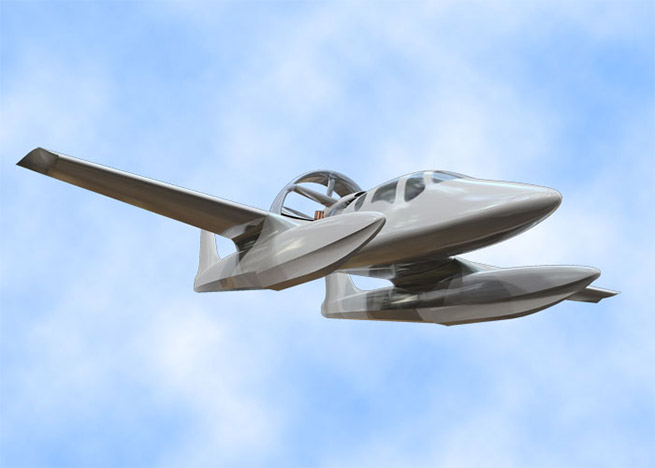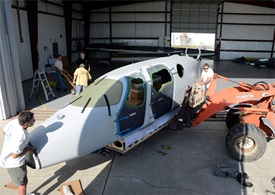
It is no accident that the new amphibian design envisioned by John Meekins and refined and engineered by the late Bill Husa bears more than a passing resemblance to the North American F-82 Twin Mustang. Meekins, a longtime pilot whose infatuation with aviation dates to his childhood, was searching for an amphibian about a decade ago that was fast, stable in the water, and able to carry his family. He tried a few, but none fit the bill.
The Twin Mustang was the last piston fighter ordered by the U.S. Air Force, and saw action in Korea. It was modeled on the P-51, with a distinctive twin-boom adaptation. The innovative design came to mind as Meekins pondered an option that few pilots pursue—building from scratch.
“It just struck me all of a sudden if the twin fuselages were actually floats, then we’d have a stable amphibian,” said Meekins, in a telephone interview.
A real estate developer with no background in aviation engineering, Meekins assembled a team, with Husa—who brought years of experience working for major aerospace firms including Boeing and General Dynamics—the principal designer.
The result of their collaboration, based in estimates and computer simulations, is an amphibian with a turbine-powered pusher prop that is able to climb to 25,000 feet; cruise at 215 knots at 15,000 feet; carry 2,000 pounds of passengers, baggage, and fuel; and clear a 50-foot obstacle at maximum weight with just 1,300 feet of water to work with. The takeoff roll on land should be shorter still.
Soon, Meekins hopes, it will fly.

Husa’s death in 2012 with the prototype under way but unfinished left the Privateer, as the new amphibian is known, in limbo. Meekins mourned the loss of his friend and searched for someone with the skills and expertise to finish the job. That search led him to Titusville, Fla., and Comp Air Aviation, where semi trucks recently delivered the parts and subassemblies already completed.
Meekins, CEO of Privateer Industries, holds four patents related to the Privateer and is working on a fifth, and recently worked out a deal with Comp Air CEO Ron Lueck, whose company will complete the prototype assembly and further develop the aircraft as both a kit-built and, eventually, a certificated aircraft.
Meekins said the kit version of the airplane he dreamed up will probably retail in the vicinity of $1.5 million for a complete kit including the Walter 601 turbine producing up to 724 horsepower, though the price is among the details that remain to be finalized. Meekins hopes to see the Privateer make its maiden flight in August. That will be “hugely exciting for me,” said Meekins, who has worked for nearly seven years to bring the Privateer to life. “It’s going to be quite a day when we take to the air.”
The Privateer will offer an innovative blend of power, stability, and relative quiet, a “huge advancement,” Meekins said. The propeller shroud will both increase power and reduce noise, noting that much of a propeller-driven aircraft’s noise comes from propeller tips slicing the air at supersonic speed. The low-wing configuration reduces drag, among the reasons Meekins expects to see a 215-knot cruise at altitude. The rear seat’s bench configuration allows for up to six passengers (Meekins said the design can be scaled up to seat 20), and the twin-boom floats give this amphibian a much wider base than many, enhancing stability in the water. On land, the tricycle landing gear maximizes ground maneuverability and promises to set the Privateer apart from other amphibians. With that gear retracted, the Privateer will float nose-high, creating a positive angle of attack at rest and making the aircraft sit in the water much like a taildragger sits on land.
Meekins said the design has been refined with virtual wind tunnel tests (computer simulations), and many of the major components are complete. Meekins said Lueck, who has built hundreds of kit aircraft including more than 200 with turboprop power, is the perfect partner to get the Privateer off the ground—or off the water, as the case may be.
“I’m very pleased with what he’s done so far,” Meekins said.



